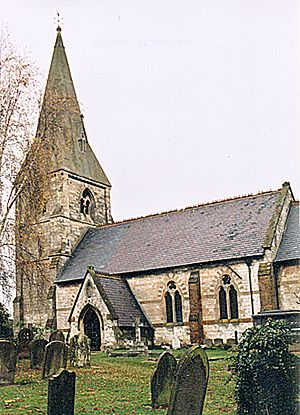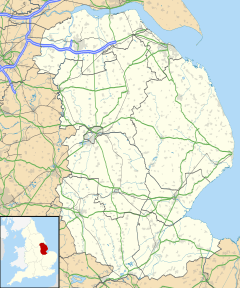Fotherby facts for kids
Quick facts for kids Fotherby |
|
|---|---|
 St Mary's Church Fotherby |
|
| OS grid reference | TF315919 |
| • London | 135 mi (217 km) S |
| District | |
| Shire county | |
| Region | |
| Country | England |
| Sovereign state | United Kingdom |
| Post town | Louth |
| Postcode district | LN11 |
| Police | Lincolnshire |
| Fire | Lincolnshire |
| Ambulance | East Midlands |
| EU Parliament | East Midlands |
| UK Parliament |
|
Fotherby is a small village located in the East Lindsey area of Lincolnshire, England. It's a quiet place, found just east of the main A16 road. You can find it about 13 miles (21 km) east of Market Rasen and 10 miles (16 km) south of Cleethorpes. Fotherby is also known as a civil parish, which is a local area with its own small government.
Contents
Fotherby's Early History
The village of Fotherby has a long history, dating back over 900 years! It was first mentioned in a very old book called the Domesday Book. This book was like a giant survey ordered by William the Conqueror in 1085. In the Domesday Book, Fotherby was written as "Fodrebi".
Before the Norman Conquest in 1066, a person named Thorgot Lag was the main owner, or Lord of the Manor, of Fotherby. After the Normans took over England, the land was given to new owners. Berengar of Tosny became the new lord, with Robert of Tosny as the main Tenant-in-chief (a very important landholder directly under the King).
Village Life in the Past
In 1885, a guide called Kelly's Directory described Fotherby. It mentioned that the village had six special houses called almshouses. These houses were built in 1866 by James Fowler to help poor people in the area. They were built on the site where an older church house, called a glebe house, once stood.
At that time, Fotherby covered about 1,400 acres (5.7 km²) of land. The main crops grown by farmers were wheat, barley, oats, turnips, seeds, and beans. In 1881, the village had a population of 188 people.
St Mary's Church
The most important building in Fotherby is the Anglican church, which is named after St Mary. This church is considered a Grade II listed building, meaning it's historically important and protected.
The church you see today was completely rebuilt in 1863 by the same architect, James Fowler. He designed it in the Early English style, which was popular for churches a long time ago. The church has a main area called the nave, a special part for the altar called the chancel, a small entrance on the south side called a porch, and a tall western tower. On top of the tower is a pointed roof called a broach spire. Inside the tower are three bells that were first made way back in 1608!
Other Historic Buildings
Besides St Mary's Church, there are a couple of other buildings in Fotherby that are also listed for their historical importance. These include Mawers Farm, which is located on Peppin Lane, and an old Sunday School building found on Church Lane. These buildings help tell the story of Fotherby's past.


